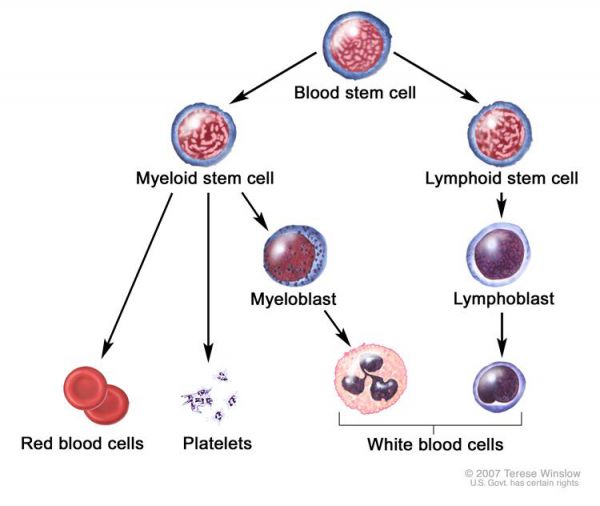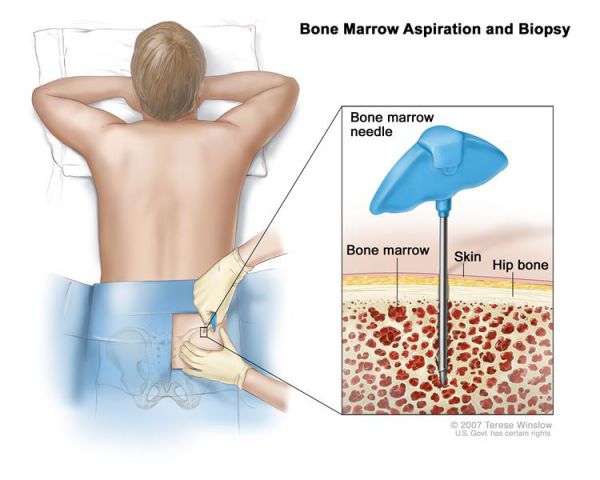Types/leukemia/patient/adult-aml-treatment-pdq
Adult Acute Myeloid Leukemia Treatment (PDQ?)–Patient Version
General Information About Adult Acute Myeloid Leukemia
KEY POINTS
- Adult acute myeloid leukemia (AML) is a type of cancer in which the bone marrow makes abnormal myeloblasts (a type of white blood cell), red blood cells, or platelets.
- Leukemia may affect red blood cells, white blood cells, and platelets.
- There are different subtypes of AML.
- Smoking, previous chemotherapy treatment, and exposure to radiation may affect the risk of adult AML.
- Signs and symptoms of adult AML include fever, feeling tired, and easy bruising or bleeding.
- Tests that examine the blood and bone marrow are used to detect (find) and diagnose adult AML.
- Certain factors affect prognosis (chance of recovery) and treatment options.
Adult acute myeloid leukemia (AML) is a type of cancer in which the bone marrow makes abnormal myeloblasts (a type of white blood cell), red blood cells, or platelets.
Adult acute myeloid leukemia (AML) is a cancer of the blood and bone marrow. This type of cancer usually gets worse quickly if it is not treated. It is the most common type of acute leukemia in adults. AML is also called acute myelogenous leukemia, acute myeloblastic leukemia, acute granulocytic leukemia, and acute nonlymphocytic leukemia.
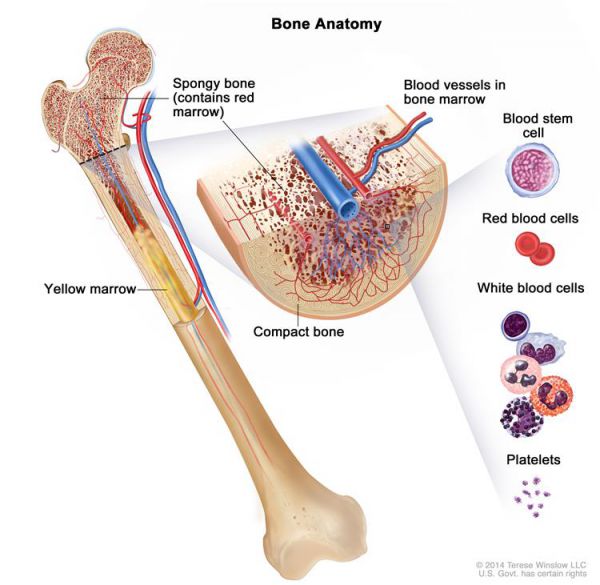
Leukemia may affect red blood cells, white blood cells, and platelets.
Normally, the bone marrow makes blood stem cells (immature cells) that become mature blood cells over time. A blood stem cell may become a myeloid stem cell or a lymphoid stem cell. A lymphoid stem cell becomes a white blood cell.
A myeloid stem cell becomes one of three types of mature blood cells:
- Red blood cells that carry oxygen and other substances to all tissues of the body.
- White blood cells that fight infection and disease.
- Platelets that form blood clots to stop bleeding.
In AML, the myeloid stem cells usually become a type of immature white blood cell called myeloblasts (or myeloid blasts). The myeloblasts in AML are abnormal and do not become healthy white blood cells. Sometimes in AML, too many stem cells become abnormal red blood cells or platelets. These abnormal white blood cells, red blood cells, or platelets are also called leukemia cells or blasts. Leukemia cells can build up in the bone marrow and blood so there is less room for healthy white blood cells, red blood cells, and platelets. When this happens, infection, anemia, or easy bleeding may occur. The leukemia cells can spread outside the blood to other parts of the body, including the central nervous system (brain and spinal cord), skin, and gums.
This summary is about adult AML. See the following PDQ summaries for information about other types of leukemia:
- Childhood Acute Myeloid Leukemia/Other Myeloid Malignancies Treatment
- Chronic Myelogenous Leukemia Treatment
- Adult Acute Lymphoblastic Leukemia Treatment
- Childhood Acute Lymphoblastic Leukemia Treatment
- Chronic Lymphocytic Leukemia Treatment
- Hairy Cell Leukemia Treatment
There are different subtypes of AML.
Most AML subtypes are based on how mature (developed) the cancer cells are at the time of diagnosis and how different they are from normal cells.
Acute promyelocytic leukemia (APL) is a subtype of AML that occurs when parts of two genes stick together. APL usually occurs in middle-aged adults. Signs of APL may include both bleeding and forming blood clots.
Smoking, previous chemotherapy treatment, and exposure to radiation may affect the risk of adult AML.
Anything that increases your risk of getting a disease is called a risk factor. Having a risk factor does not mean that you will get cancer; not having risk factors doesn’t mean that you will not get cancer. Talk with your doctor if you think you may be at risk. Possible risk factors for AML include the following:
- Being male.
- Smoking, especially after age 60.
- Having had treatment with chemotherapy or radiation therapy in the past.
- Having had treatment for childhood acute lymphoblastic leukemia (ALL) in the past.
- Being exposed to radiation from an atomic bomb or to the chemical benzene.
- Having a history of a blood disorder such as myelodysplastic syndrome.
Signs and symptoms of adult AML include fever, feeling tired, and easy bruising or bleeding.
The early signs and symptoms of AML may be like those caused by the flu or other common diseases. Check with your doctor if you have any of the following:
- Fever.
- Shortness of breath.
- Easy bruising or bleeding.
- Petechiae (flat, pinpoint spots under the skin caused by bleeding).
- Weakness or feeling tired.
- Weight loss or loss of appetite.
Tests that examine the blood and bone marrow are used to detect (find) and diagnose adult AML.
The following tests and procedures may be used:
- Physical exam and history: An exam of the body to check general signs of health, including checking for signs of disease, such as lumps or anything else that seems unusual. A history of the patient’s health habits and past illnesses and treatments will also be taken.
- Complete blood count (CBC): A procedure in which a sample of blood is drawn and checked for the following:
- The number of red blood cells, white blood cells, and platelets.
- The amount of hemoglobin (the protein that carries oxygen) in the red blood cells.
- The portion of the sample made up of red blood cells.
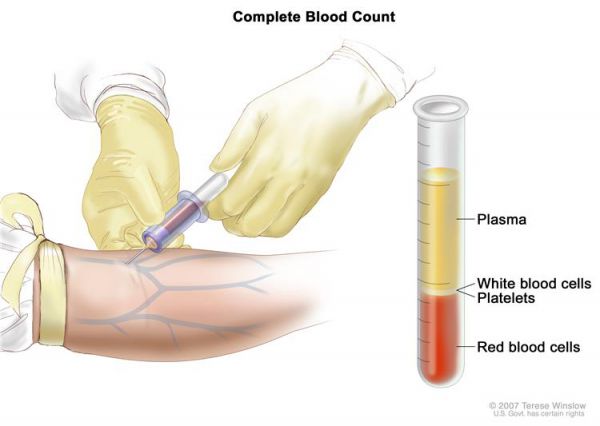
- Peripheral blood smear: A procedure in which a sample of blood is checked for blast cells, the number and kinds of white blood cells, the number of platelets, and changes in the shape of blood cells.
- Bone marrow aspiration and biopsy: The removal of bone marrow, blood, and a small piece of bone by inserting a hollow needle into the hipbone or breastbone. A pathologist views the bone marrow, blood, and bone under a microscope to look for signs of cancer.
- Cytogenetic analysis: A laboratory test in which the chromosomes of cells in a sample of blood or bone marrow are counted and checked for any changes, such as broken, missing, rearranged, or extra chromosomes. Changes in certain chromosomes may be a sign of cancer. Cytogenetic analysis is used to help diagnose cancer, plan treatment, or find out how well treatment is working. Other tests, such as fluorescence in situ hybridization (FISH), may also be done to look for certain changes in the chromosomes.
- Immunophenotyping: A laboratory test that uses antibodies to identify cancer cells based on the types of antigens or markers on the surface of the cells. This test is used to help diagnose specific types of leukemia. For example, a cytochemistry study may test the cells in a sample of tissue using chemicals (dyes) to look for certain changes in the sample. A chemical may cause a color change in one type of leukemia cell but not in another type of leukemia cell.
- Reverse transcription–polymerase chain reaction test (RT–PCR): A laboratory test in which the amount of a genetic substance called mRNA made by a specific gene is measured. An enzyme called reverse transcriptase is used to convert a specific piece of RNA into a matching piece of DNA, which can be amplified (made in large numbers) by another enzyme called DNA polymerase. The amplified DNA copies help tell whether a specific mRNA is being made by a gene. RT-PCR can be used to check the activation of certain genes that may indicate the presence of cancer cells. This test may be used to look for certain changes in a gene or chromosome, which may help diagnose cancer. This test is used to diagnose certain types of AML including acute promyelocytic leukemia (APL).
Certain factors affect prognosis (chance of recovery) and treatment options.
The prognosis (chance of recovery) and treatment options depend on:
- The age of the patient.
- The subtype of AML.
- Whether the patient received chemotherapy in the past to treat a different cancer.
- Whether there is a history of a blood disorder such as myelodysplastic syndrome.
- Whether the cancer has spread to the central nervous system.
- Whether the cancer has been treated before or recurred (come back).
It is important that acute leukemia be treated right away.
Stages of Adult Acute Myeloid Leukemia
KEY POINTS
- Once adult acute myeloid leukemia (AML) has been diagnosed, tests are done to find out if the cancer has spread to other parts of the body.
- There is no standard staging system for adult AML.
Once adult acute myeloid leukemia (AML) has been diagnosed, tests are done to find out if the cancer has spread to other parts of the body.
The extent or spread of cancer is usually described as stages. In adult acute myeloid leukemia (AML), the subtype of AML and whether the leukemia has spread outside the blood and bone marrow are used instead of the stage to plan treatment. The following tests and procedures may be used to determine if the leukemia has spread:
- Lumbar puncture: A procedure used to collect a sample of cerebrospinal fluid (CSF) from the spinal column. This is done by placing a needle between two bones in the spine and into the CSF around the spinal cord and removing a sample of the fluid. The sample of CSF is checked under a microscope for signs that leukemia cells have spread to the brain and spinal cord. This procedure is also called an LP or spinal tap.

- CT scan (CAT scan): A procedure that makes a series of detailed pictures of the abdomen, taken from different angles. The pictures are made by a computer linked to an x-ray machine. A dye may be injected into a vein or swallowed to help the organs or tissues show up more clearly. This procedure is also called computed tomography, computerized tomography, or computerized axial tomography.
There is no standard staging system for adult AML.
The disease is described as untreated, in remission, or recurrent.
Untreated adult AML
In untreated adult AML, the disease is newly diagnosed. It has not been treated except to relieve signs and symptoms such as fever, bleeding, or pain, and the following are true:
- The complete blood count is abnormal.
- At least 20% of the cells in the bone marrow are blasts (leukemia cells).
- There are signs or symptoms of leukemia.
Adult AML in remission
In adult AML in remission, the disease has been treated and the following are true:
- The complete blood count is normal.
- Less than 5% of the cells in the bone marrow are blasts (leukemia cells).
- There are no signs or symptoms of leukemia in the brain and spinal cord or elsewhere in the body.
Recurrent Adult AML
Recurrent AML is cancer that has recurred (come back) after it has been treated. The AML may come back in the blood or bone marrow.
Treatment Option Overview
KEY POINTS
- There are different types of treatment for patients with adult acute myeloid leukemia.
- The treatment of adult AML usually has 2 phases.
- Four types of standard treatment are used:
- Chemotherapy
- Radiation therapy
- Chemotherapy with stem cell transplant
- Other drug therapy
- New types of treatment are being tested in clinical trials.
- Targeted therapy
- Treatment for adult acute myeloid leukemia may cause side effects.
- Patients may want to think about taking part in a clinical trial.
- Patients can enter clinical trials before, during, or after starting their cancer treatment.
- Follow-up tests may be needed.
There are different types of treatment for patients with adult acute myeloid leukemia.
Different types of treatment are available for patients with adult acute myeloid leukemia (AML). Some treatments are standard (the currently used treatment), and some are being tested in clinical trials. A treatment clinical trial is a research study meant to help improve current treatments or obtain information on new treatments for patients with cancer. When clinical trials show that a new treatment is better than the standard treatment, the new treatment may become the standard treatment. Patients may want to think about taking part in a clinical trial. Some clinical trials are open only to patients who have not started treatment.
The treatment of adult AML usually has 2 phases.
The 2 treatment phases of adult AML are:
- Remission induction therapy: This is the first phase of treatment. The goal is to kill the leukemia cells in the blood and bone marrow. This puts the leukemia into remission.
- Post-remission therapy: This is the second phase of treatment. It begins after the leukemia is in remission. The goal of post-remission therapy is to kill any remaining leukemia cells that may not be active but could begin to regrow and cause a relapse. This phase is also called remission continuation therapy.
Four types of standard treatment are used:
Chemotherapy
Chemotherapy is a cancer treatment that uses drugs to stop the growth of cancer cells, either by killing the cells or by stopping them from dividing. When chemotherapy is taken by mouth or injected into a vein or muscle, the drugs enter the bloodstream and can reach cancer cells throughout the body (systemic chemotherapy). When chemotherapy is placed directly into the cerebrospinal fluid (intrathecal chemotherapy), an organ, or a body cavity such as the abdomen, the drugs mainly affect cancer cells in those areas (regional chemotherapy). Intrathecal chemotherapy may be used to treat adult AML that has spread to the brain and spinal cord. Combination chemotherapy is treatment using more than one anticancer drug.
The way the chemotherapy is given depends on the subtype of AML being treated and whether leukemia cells have spread to the brain and spinal cord.

See Drugs Approved for Acute Myeloid Leukemia for more information.
Radiation therapy
Radiation therapy is a cancer treatment that uses high-energy x-rays or other types of radiation to kill cancer cells or keep them from growing. There are two types of radiation therapy:
- External radiation therapy uses a machine outside the body to send radiation toward the cancer.
- Internal radiation therapy uses a radioactive substance sealed in needles, seeds, wires, or catheters that are placed directly into or near the cancer.
The way the radiation therapy is given depends on the type of cancer being treated and whether leukemia cells have spread to the brain and spinal cord. External radiation therapy is used to treat adult AML.
Chemotherapy with stem cell transplant
Chemotherapy is given to kill cancer cells. Healthy cells, including blood-forming cells, are also destroyed by the cancer treatment. Stem cell transplant is a treatment to replace the blood-forming cells. Stem cells (immature blood cells) are removed from the blood or bone marrow of the patient or a donor and are frozen and stored. After the patient completes chemotherapy, the stored stem cells are thawed and given back to the patient through an infusion. These reinfused stem cells grow into (and restore) the body's blood cells.
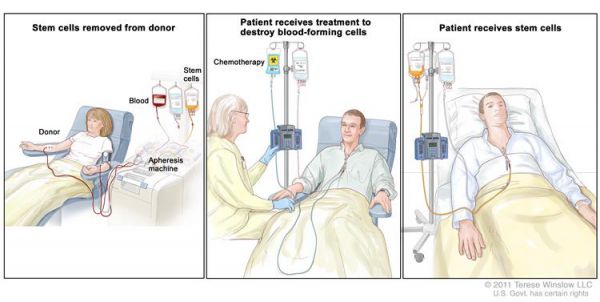
Other drug therapy
Arsenic trioxide and all-trans retinoic acid (ATRA) are anticancer drugs that kill leukemia cells, stop the leukemia cells from dividing, or help the leukemia cells mature into white blood cells. These drugs are used in the treatment of a subtype of AML called acute promyelocytic leukemia.
See Drugs Approved for Acute Myeloid Leukemia for more information.
New types of treatment are being tested in clinical trials.
This summary section describes treatments that are being studied in clinical trials. It may not mention every new treatment being studied. Information about clinical trials is available from the NCI website.
Targeted therapy
Targeted therapy is a type of treatment that uses drugs or other substances to identify and attack specific cancer cells without harming normal cells. Monoclonal antibody therapy is one type of targeted therapy being studied in the treatment of adult AML.
Monoclonal antibody therapy is a cancer treatment that uses antibodies made in the laboratory from a single type of immune system cell. These antibodies can identify substances on cancer cells or normal substances that may help cancer cells grow. The antibodies attach to the substances and kill the cancer cells, block their growth, or keep them from spreading. Monoclonal antibodies are given by infusion. They may be used alone or to carry drugs, toxins, or radioactive material directly to cancer cells.
Treatment for adult acute myeloid leukemia may cause side effects.
For information about side effects caused by treatment for cancer, see our Side Effects page.
Patients may want to think about taking part in a clinical trial.
For some patients, taking part in a clinical trial may be the best treatment choice. Clinical trials are part of the cancer research process. Clinical trials are done to find out if new cancer treatments are safe and effective or better than the standard treatment.
Many of today's standard treatments for cancer are based on earlier clinical trials. Patients who take part in a clinical trial may receive the standard treatment or be among the first to receive a new treatment.
Patients who take part in clinical trials also help improve the way cancer will be treated in the future. Even when clinical trials do not lead to effective new treatments, they often answer important questions and help move research forward.
Patients can enter clinical trials before, during, or after starting their cancer treatment.
Some clinical trials only include patients who have not yet received treatment. Other trials test treatments for patients whose cancer has not gotten better. There are also clinical trials that test new ways to stop cancer from recurring (coming back) or reduce the side effects of cancer treatment.
Clinical trials are taking place in many parts of the country. Information about clinical trials supported by NCI can be found on NCI’s clinical trials search webpage. Clinical trials supported by other organizations can be found on the ClinicalTrials.gov website.
Follow-up tests may be needed.
Some of the tests that were done to diagnose the cancer or to find out the stage of the cancer may be repeated. Some tests will be repeated in order to see how well the treatment is working. Decisions about whether to continue, change, or stop treatment may be based on the results of these tests.
Some of the tests will continue to be done from time to time after treatment has ended. The results of these tests can show if your condition has changed or if the cancer has recurred (come back). These tests are sometimes called follow-up tests or check-ups.
Treatment Options for Adult Acute Myeloid Leukemia
In This Section
- Untreated Adult Acute Myeloid Leukemia
- Adult Acute Myeloid Leukemia in Remission
- Recurrent Adult Acute Myeloid Leukemia
For information about the treatments listed below, see the Treatment Option Overview section.
Untreated Adult Acute Myeloid Leukemia
Standard treatment of untreated adult acute myeloid leukemia (AML) during the remission induction phase depends on the subtype of AML and may include the following:
- Combination chemotherapy.
- High-dose combination chemotherapy.
- Low-dose chemotherapy.
- Intrathecal chemotherapy.
- All-trans retinoic acid (ATRA) plus arsenic trioxide for the treatment of acute promyelocytic leukemia (APL).
- ATRA plus combination chemotherapy followed by arsenic trioxide for the treatment of APL.
Use our clinical trial search to find NCI-supported cancer clinical trials that are accepting patients. You can search for trials based on the type of cancer, the age of the patient, and where the trials are being done. General information about clinical trials is also available.
Adult Acute Myeloid Leukemia in Remission
Treatment of adult AML during the remission phase depends on the subtype of AML and may include the following:
- Combination chemotherapy.
- High-dose chemotherapy, with or without radiation therapy, and stem cell transplant using the patient's stem cells.
- High-dose chemotherapy and stem cell transplant using donor stem cells.
- A clinical trial of arsenic trioxide.
Use our clinical trial search to find NCI-supported cancer clinical trials that are accepting patients. You can search for trials based on the type of cancer, the age of the patient, and where the trials are being done. General information about clinical trials is also available.
Recurrent Adult Acute Myeloid Leukemia
There is no standard treatment for recurrent adult AML. Treatment depends on the subtype of AML and may include the following:
- Combination chemotherapy.
- Targeted therapy with monoclonal antibodies.
- Stem cell transplant using the patient's stem cells or donor stem cells.
- Arsenic trioxide therapy.
- A clinical trial of arsenic trioxide therapy followed by stem cell transplant.
Use our clinical trial search to find NCI-supported cancer clinical trials that are accepting patients. You can search for trials based on the type of cancer, the age of the patient, and where the trials are being done. General information about clinical trials is also available.
To Learn More About Adult Acute Myeloid Leukemia Cancer
For more information from the National Cancer Institute about adult acute myeloid leukemia, see the following:
- Leukemia Home Page
- Drugs Approved for Acute Myeloid Leukemia
- Blood-Forming Stem Cell Transplants
- Targeted Cancer Therapies
For general cancer information and other resources from the National Cancer Institute, see the following:
- About Cancer
- Staging
- Chemotherapy and You: Support for People With Cancer
- Radiation Therapy and You: Support for People With Cancer
- Coping with Cancer
- Questions to Ask Your Doctor about Cancer
- For Survivors and Caregivers
